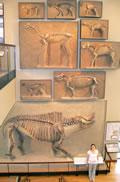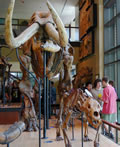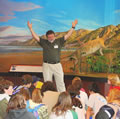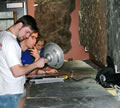
A Museum for All Seasons:
The Amherst College Museum of Natural History
The beauty and genius of a work of art may be reconceived, though its first material expression be destroyed; a vanished harmony may yet again inspire the composer; but when the last individual of a race of living things breathes no more, another heaven and another earth must pass before such a one can be again.
— William Beebe, American Naturalist 1906
 When colleges and universities
make the decision to give away or sell their collections (sometimes to
buy other collections); when some collections are tossed out to make way
for student centers; when others burn or are lost to theft and neglect,
we lose the source material for much of what we know about the evolution
of life on the planet. We lose our connections to the history of
scientific collecting and to those researchers who were in the vanguard
of paleontology. Our students lose that indescribable pleasure of
holding a mammoth tooth in their hands and reflecting on that tooth’s
improbable journey to their classroom.
When colleges and universities
make the decision to give away or sell their collections (sometimes to
buy other collections); when some collections are tossed out to make way
for student centers; when others burn or are lost to theft and neglect,
we lose the source material for much of what we know about the evolution
of life on the planet. We lose our connections to the history of
scientific collecting and to those researchers who were in the vanguard
of paleontology. Our students lose that indescribable pleasure of
holding a mammoth tooth in their hands and reflecting on that tooth’s
improbable journey to their classroom.
Amherst College found itself with the problem of having a large and important collection that had largely lay moribund for many decades. In 2003 the College administration wanted the building, an architecturally important one hundred and forty-year-old gymnasium, for a freshman dormitory. The geology faculty was promised a new building and all that came with it—modern labs, prep rooms, offices, classrooms and lecture halls. The dusty and dark old museum, used by a few paleontology classes a few times per semester, and visited by school groups and the public with a total yearly attendance of about three thousand, was a very different matter. How could such a small use justify a ten million dollar exhibit hall? Not even the entire geology faculty of five could agree that it was financially sensible, let alone a Board of Trustees.
 As the new Earth Sciences
Building began its life on paper and in committee rooms something
remarkable occurred. The College took the time to reflect on the
collection itself, the role of the collection in teaching geology, the
value, if any, to the rest of the college community, and finally, to the
role the museum had in the community for public education. Faculty from
other disciplines stepped forward to plead the case for a new museum.
The geology faculty began the process of characterizing the scope of the
collections, numbering eighty thousand objects collected throughout the
history of the college, beginning in 1825 and stretching back to the
early years of geology and paleontology. The collections were remarkably
complete and contained many type specimens including the skull of a Pyrothere and the world’s largest collection of dinosaur trackways
collected by Edward Hitchcock in the middle of the 19th
century.
As the new Earth Sciences
Building began its life on paper and in committee rooms something
remarkable occurred. The College took the time to reflect on the
collection itself, the role of the collection in teaching geology, the
value, if any, to the rest of the college community, and finally, to the
role the museum had in the community for public education. Faculty from
other disciplines stepped forward to plead the case for a new museum.
The geology faculty began the process of characterizing the scope of the
collections, numbering eighty thousand objects collected throughout the
history of the college, beginning in 1825 and stretching back to the
early years of geology and paleontology. The collections were remarkably
complete and contained many type specimens including the skull of a Pyrothere and the world’s largest collection of dinosaur trackways
collected by Edward Hitchcock in the middle of the 19th
century.
Once a consensus had been reached by the College that there could be real value in a new museum, the geology faculty plunged into the task of museum design that would make the collection relevant to undergraduate education, the primary mission of Amherst College. At the same time there was a conscious effort to avoid any design features that would make the museum an attraction to school children- this was to be an academic teaching museum for serious undergraduates in geology. It was to be object rich and without modern interactive displays. The collection would be the central exhibit. The interpretive labels would be written for the college student already immersed in college level science laboratories and research.
 The collections themselves
determined the broad themes of the new museum. These themes include
extinction, climate change, evolution, plate tectonics, and the geology
of the Connecticut River Valley of Massachusetts. The fossils would be
central to each exhibit, each of them standing alone as the narrator of
a compelling history. The faculty made a commitment to use the museum as
a teaching laboratory. A wonderful concept called “the beltway” was
introduced with a series of drawers illustrating high points of the
evolution of vertebrates, invertebrates and plants was placed on two of
the museum floors. This belt cuts through the storage cabinets that line
the museum walls. Students pull open the drawers to see one or more
choice specimens from the collections—these were selected by the
faculty as good examples of these evolutionary signposts or markers. The
collections spill out into the hallways of the Earth Science Building
and glass cases make it possible to see into each other’s domain.
The collections themselves
determined the broad themes of the new museum. These themes include
extinction, climate change, evolution, plate tectonics, and the geology
of the Connecticut River Valley of Massachusetts. The fossils would be
central to each exhibit, each of them standing alone as the narrator of
a compelling history. The faculty made a commitment to use the museum as
a teaching laboratory. A wonderful concept called “the beltway” was
introduced with a series of drawers illustrating high points of the
evolution of vertebrates, invertebrates and plants was placed on two of
the museum floors. This belt cuts through the storage cabinets that line
the museum walls. Students pull open the drawers to see one or more
choice specimens from the collections—these were selected by the
faculty as good examples of these evolutionary signposts or markers. The
collections spill out into the hallways of the Earth Science Building
and glass cases make it possible to see into each other’s domain.
Rising thirty feet above the floor and visitors is a wall of Cenozoic mammals collected by the College’s own Frederick Loomis, one of the towering paleontologists of the early 20th century. Therein is another singular aspect of the Amherst collection- almost all of it was collected by the college’s professors and their students. Loomis would end each academic year by soliciting student assistants to spend the summer out on expeditions and within the week he would have purchased a new Model T Ford truck and headed out into dust-bowl America with a few students to dig fossils under the blazing sun, drink bad coffee, eat stale biscuits, and sleep under rough wool blankets beneath the cold clear stars of the prairie and deserts of America and Patagonia.
 In the evening the main hall
remains lighted so that students can see the great skeletons of the
mammoth and mastodon keeping watch over the campus. A stunning display
of the dinosaur trackways discovered and first studied by Amherst
professor and president Edward Hitchcock commands the ground floor. The
trackways hang on walls and an immense steel rack system; slabs are
lighted by LED strips for high contrast viewing. Above, in the darkened
ceiling, the air exchange system whispers and echoes in the cavernous
room. All twelve hundred slabs collected by Hitchcock and containing
more than twenty-one thousand individual traces are housed in the
museum.
In the evening the main hall
remains lighted so that students can see the great skeletons of the
mammoth and mastodon keeping watch over the campus. A stunning display
of the dinosaur trackways discovered and first studied by Amherst
professor and president Edward Hitchcock commands the ground floor. The
trackways hang on walls and an immense steel rack system; slabs are
lighted by LED strips for high contrast viewing. Above, in the darkened
ceiling, the air exchange system whispers and echoes in the cavernous
room. All twelve hundred slabs collected by Hitchcock and containing
more than twenty-one thousand individual traces are housed in the
museum.
It has been eighteen months since the museum opened and some stunning, serendipitous educational outcomes have begun to emerge. Twenty-five thousand visitors have replaced the three thousand annual visitors annually. Enrollment in the department’s introductory course, Geo 11, has exploded. Amherst College students from the biology and art departments have become regular users. The four other colleges in the immediate area are now sending students over to complete lab assignments and many of the colleges in New England have been placing the museum on their field trip itineraries. The College’s admission tours traipse through many times during the day and prospective students and their parents stand gape-jawed before the Pleistocene behemoths for a few moments before realizing that no where else on their college visits have they seen such an homage to scientific collecting and the self-evident truth of evolution and extinction. Too many colleges and universities took that other path and divested themselves of their scientific heritage.
 I am the College’s informal
science educator. I run the college’s ancient planetarium and our
educational programs at the new (and the old) Museum of Natural History.
When I was faced with the Trustees’ disinterest in public, non-Amherst
College undergraduate education I did not lose heart because I too
believed in the power of the specimens themselves to teach and to
inspire. I had little interest in the label text because as a long time
museum educator I had noticed that few people read labels. When I
fretted over the height of water fountains and toilets, the Americans
with Disabilities Act made sure that humans shorter than twenty year
olds would have access as well as those confined to wheelchairs.
I am the College’s informal
science educator. I run the college’s ancient planetarium and our
educational programs at the new (and the old) Museum of Natural History.
When I was faced with the Trustees’ disinterest in public, non-Amherst
College undergraduate education I did not lose heart because I too
believed in the power of the specimens themselves to teach and to
inspire. I had little interest in the label text because as a long time
museum educator I had noticed that few people read labels. When I
fretted over the height of water fountains and toilets, the Americans
with Disabilities Act made sure that humans shorter than twenty year
olds would have access as well as those confined to wheelchairs.
 As the museum neared opening I
realized that I would have to change how I managed groups in the museum.
The faculty could have their students’ use the museum with its doors
locked and some even suggested that preference. We did eventually settle
on public hours that would provide access for 30 hours per week. As the
only educator I had to put a great deal of faith in the skills of the
museum docents. In the past these had been sleepy undergraduates tasked
with keeping the fossils from being carried off. I undertook an overhaul
of their duties and turned them into skilled educators. I went from
desperately advertising for student workers to fending them off. Each
semester I now have thirty to forty applicants for ten positions. I
pluck these students out of the geology hallways and as some lead
college tours through the museum. I have geology majors as well as women
and gender studies majors. My task has been to find outgoing, articulate
students who can express themselves with animation, a joy of learning,
and pleasure at speaking with a toddler or an octogenarian. I require
that they speak about the exhibits extemporaneously, rather than learn a
speech by rote and parrot something they themselves do not understand.
As the museum neared opening I
realized that I would have to change how I managed groups in the museum.
The faculty could have their students’ use the museum with its doors
locked and some even suggested that preference. We did eventually settle
on public hours that would provide access for 30 hours per week. As the
only educator I had to put a great deal of faith in the skills of the
museum docents. In the past these had been sleepy undergraduates tasked
with keeping the fossils from being carried off. I undertook an overhaul
of their duties and turned them into skilled educators. I went from
desperately advertising for student workers to fending them off. Each
semester I now have thirty to forty applicants for ten positions. I
pluck these students out of the geology hallways and as some lead
college tours through the museum. I have geology majors as well as women
and gender studies majors. My task has been to find outgoing, articulate
students who can express themselves with animation, a joy of learning,
and pleasure at speaking with a toddler or an octogenarian. I require
that they speak about the exhibits extemporaneously, rather than learn a
speech by rote and parrot something they themselves do not understand.
As of December 2007, we have had some 36,000 visitors of all ages. The museum is used by the faculty and students at Amherst College as it was envisioned, a serious resource for undergraduate education. The College, so heavily invested in cultivating relationships with alumni, parents and prospective students has found the museum to be the jewel in the college’s treasures. The students who work at the museum have found a rewarding experience in educating visitors and an esprit de corps that has spread by word of mouth as one of the campus’s must-have cult jobs. The community has once again been given a reminder that the College is part of it, that it is willing to share its resources. Finally, the College has shown its commitment to continue as the responsible steward of an important collection and the preservation of the College’s scientific history.